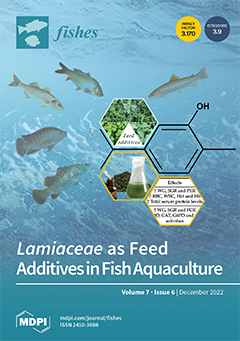Kidney-type glutaminase, encoded by the
gls1 gene, plays a critical role in glutamate production and improvement of meat flavor. In this study, a
gls1 gene encoding 595 amino acids was cloned from triploid crucian carp (
Carassius auratus) (TCC) and showed a
[...] Read more.
Kidney-type glutaminase, encoded by the
gls1 gene, plays a critical role in glutamate production and improvement of meat flavor. In this study, a
gls1 gene encoding 595 amino acids was cloned from triploid crucian carp (
Carassius auratus) (TCC) and showed a high similarity with the
gls1 gene found in
Cyprinus carpio,
Sinocyclocheilus rhinocerous and
Puntigrus tetrazona. Comparing the abundance of
gls1 in different tissues, we found its expression level in the brain and liver were significantly higher than that in heart, gut, kidney, spleen and muscle.
gls1 expression in the brain reached the highest value. In addition, the expression levels of
gls1 also appeared different in diurnal variation, with the highest expression seen at 9:00, while it was low at 3:00, 6:00, 15:00 and 24:00. Furthermore, dietary regulation of
gls1 expression was investigated in our study. In each feeding trial, each diet was randomly assigned to triplicate tanks. Fish were fed one of the tested diets up to satiation twice daily. The results showed that
gls1 expression increased in 32% protein group and decreased in 35–41% protein group. The results of different protein source experiments showed that the expression of
gls1 gene in the mixed protein group (the control group) was significantly higher than that in the fish meal and soybean meal groups. Glutamate treatment revealed that appropriate concentrations (0.10 mg/mL in vivo and 2.00% in vitro) of glutamate remarkably improved the expression of
gls1. Besides, diets supplemented with 0.80–1.60% lysine-glutamate dipeptide exhibited a down regulatory impact on
gls1 expression. In conclusion, this study demonstrated that the expression of
gls1 in TCC was increased by 32% protein diet, mixed protein source diet and diet with 2.00% glutamate concentration, while decreased by 0.80–1.60% lysine-glutamate dipeptide. The findings of this study provide a reference for the regulation of
gls1 and have a potential application in the optimization of dietary formula in aquaculture.
Full article





